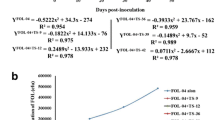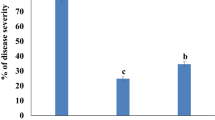Abstract
Grey mould caused by Botrytis cinerea leads to severe economic loss on commercial tomato production. Application of beneficial microorganism offers an eco-friendly alternative for mitigation of tomato fungal disease damage, considering negative influences of fungicides. In the present study, an antagonistic Trichoderma afroharzianum isolate TM24 was evaluated for its biocontrol potential on tomato grey mould. The isolate TM24 showed obviously antagonistic effect on B. cinerea mycelium growth and production of glucanase and chitinase. Leaf spraying with spore suspension of isolate TM24 showed a biocontrol efficiency of over 54% against tomato grey mould in greenhouse pot experiment. The activities of plant defense-related enzymes including polyphenol oxidase, phenylalanine ammonialyase, superoxide dismutase, and peroxidase were all increased to varying degrees in tomato leaves after isolate TM24 treatment. Transcriptome analysis showed that, a total of 1941, 1753 and 38 differentially expressed genes (DEGs) were obtained at 24, 48 and 72 hpi, respectively, in tomato leaves pretreated with T. afroharzianum TM24, and then challenged with B. cinerea inoculation. The DEGs were mainly enriched in MAPK signaling pathway and plant hormones signal transduction pathway. Multiple genes that regulated crucial nodes of defense-related pathways, like flavonoid, phenylpropanoid, jasmonic acid and ethylene metabolisms were also identified, which may have positive correlations with the biocontrol potential of isolate TM24 in tomato plants. These promising results provided valuable information on using T. afroharzianum TM24 as a beneficial biocontrol agent in tomato grey mould management.





Similar content being viewed by others
Data Availability
The RNA-seq data were saved as FASTQ files, and deposited into National Center for Biotechnology Information under accession numbers of BioProject PRJNA666988 and BioSample SAMN16339768-16339785.
References
Liu S, Hai F, Jiang J (2017) Sensitivity to fludioxonil of Botrytis cinerea isolates from tomato in Henan province of China and characterizations of fludioxonil-resistant mutants. J Phytopathol 165:98–104
Liu SM, Che ZP, Chen GQ (2016) Multiple-fungicide resistance to carbendazim, diethofencarb, procymidone, and pyrimethanil in field isolates of Botrytis cinerea from tomato in Henan Province, China. Crop Prot 84:56–61
Xu SJ, Park DH, Kim JY, Kim BS (2016) Biological control of gray mold and growth promotion of tomato using Bacillus spp. isolated from soil. Trop Plant Pathol 41:169–176
Gao P, Qin J, Li D, Zhou S (2018) Inhibitory effect and possible mechanism of a Pseudomonas strain QBA5 against gray mold on tomato leaves and fruits caused by Botrytis cinerea. PLoS ONE 13:0190932
You JQ, Zhang J, Wu MD, Yang L, Chen WD, Li GQ (2016) Multiple criteria-based screening of Trichoderma isolates for biological control of Botrytis cinerea on tomato. Biol Control 101:31–38
Boukaew S, Prasertsan P, Troulet C, Bardin M (2017) Biological control of tomato gray mold caused by Botrytis cinerea by using Streptomyces spp. Bio Control 62:793–803
Teak SS, Nan HY, Jaeho L, Gyung JC, Jin CK, Chul SS (2017) Development of a biofungicide using a mycoparasitic fungus Simplicillium lamellicola BCP and its control efficacy against gray mold diseases of tomato and Ginseng. Plant Pathol J 33:337–344
Kumari S, Tayal P, Sharma E, Kapoor R (2014) Analyses of genetic and pathogenic variability among Botrytis cinerea isolates. Microbiol Res 169:862–872
Lopes FAC, Steindorff AS, Geraldine AM (2012) Biochemical and metabolic profiles of Trichoderma strains isolated from common bean crops in the Brazilian Cerrado, and potential antagonism against Sclerotinia sclerotiorum. Fungal Biol 116:815–824
El Komy MH, Saleh AA, Eranthodi A, Molan YY (2015) Characterization of novel Trichoderma asperellum isolates to select effective biocontrol agents against tomato Fusarium wilt. Plant Pathol J 31:50–60
Mwangi MW, Muiru WM, Narla RD, Kimenju JW, Kariuki GM (2019) Management of Fusarium oxysporum f. sp. lycopersici and root-knot nematode disease complex in tomato by use of antagonistic fungi, plant resistance and neem. Biocontrol Sci Technol 29:207–216
Zhang FL, Liu C, Wang Y, Dou K, Chen F, Pang L, Kong X, Shang C, Li Y (2020) Biological characteristic and biocontrol mechanism of Trichoderma harzianum T-A66 against bitter gourd wilt caused by Fusarium oxysporum. J Plant Pathol 102:1107–1120
Abo-Elyousr KAM, Abdel-Hafez SII, Abdel-Rahim IR (2014) Isolation of Trichoderma and evaluation of their antagonistic potential against Alternaria porri. J Phytopathol 162:567–574
Irene CC, José LTC, Concepción OG, Enrique M, Rosa H, Rafael MJD (2016) Trichoderma asperellum is effective for biocontrol of Verticillium wilt in olive caused by the defoliating pathotype of Verticillium dahlia. Crop Prot 88:45–52
Swain H, Adak T, Mukherjee AK, Mukherjee PK, Bhattacharyya P, Behera S, Bagchi TB, Patro RS, Khandual A, Bag MK, Dangar TK, Lenka S, Jena M (2018) Novel Trichoderma strains isolated from tree barks as potential biocontrol agents and biofertilizers for direct seeded rice. Microbiol Res 214:83–90
Abbey JA, Percival D, Abbey L, Asiedu SK, Prithiviraj B, Schilder A (2019) Biofungicides as alternative to synthetic fungicide control of grey mould (Botrytis cinerea)—prospects and challenges. Biocontrol Sci Technol 29:241–262
John RP, Tyagi RD, Prévost D, Brar SK, Pouleur S, Surampalli RY (2010) Mycoparasitic Trichoderma viride as a biocontrol agent against Fusarium oxysporum f. sp. adzuki and Pythium arrhenomanes and as a growth promoter of soybean. Crop Prot 29:1452–1459
Vinale F, Manganiello G, Nigro M, Mazzei P, Piccolo A, Pascale A, Ruocco M, Marra R, Lombardi N, Lanzuise S, Varlese R, Cavallo P, Lorito M, Woo SL (2014) A novel fungal metabolite with beneficial properties for agricultural applications. Molecules 19:9760–9772
Yuan J, Zhang W, Sun K, Tang MJ, Chen PX, Li X, Dai CC (2019) Comparative transcriptomics and proteomics of Atractylodes lancea in response to endophytic fungus Gilmaniella sp. AL12 reveals regulation in plant metabolism. Front Microbiol 10:1208
Zhang Y, Yang N, Zhao LH, Zhu HQ, Tang CM (2020) Transcriptome analysis reveals the defense mechanism of cotton against Verticillium dahliae in the presence of the biocontrol fungus Chaetomium globosum CEF-082. BMC Plant Biol 20:89
Coppola M, Diretto G, Digilio MC, Woo SL, Giuliano G, Molisso D, Pennacchio F, Lorito M, Rao R (2019) Transcriptome and metabolome reprogramming in tomato plants by Trichoderma harzianum strain T22 primes and enhances defense responses against aphids. Front Physiol 10:e745
Zhao J, Liu T, Liu WC, Zhang DP, Dong D, Wu HL, Zhang TT, Liu DW (2021) Transcriptomic insights into growth promotion effect of Trichoderma afroharzianum TM2-4 microbial agent on tomato plants. J Integr Agric 20:1266–1276
Qualhato T, Lopes F, Steindorff A, Brando R, Jesuino R, Ulhoa C (2013) Mycoparasitism studies of Trichoderma species against three phytopathogenic fungi: evaluation of antagonism and hydrolytic enzyme production. Biotechnol Lett 35:1461–1468
Sock J, Rohringer R, Kang Z (1990) Extracellular β-1, 3-glucanases in stem rust-affected and abiotically stressed wheat leaves. Plant Physiol 94:1376–1389
Yuan M, Huang YY, Ge WN, Jia ZH, Song SS, Zhang L, Huang YL (2019) Involvement of jasmonic acid, ethylene and salicylic acid signaling pathways behind the systemic resistance induced by Trichoderma longibrachiatum H9 in cucumber. BMC Genomics 20:144
Jiang CH, Wu F, Yu ZY, Xie P, Ke HJ, Li HW, Yu YY, Guo JH (2015) Study on screening and antagonistic mechanisms of Bacillus amyloliquefaciens against bacterial fruit blotch (BFB) caused by Acidovorax avenae subsp. citrulli. Microbiol Res 170:95–104
Livak KJ, Schmittgen TD (2001) Analysis of relative gene expression data using real-time quantitative PCR and the 2 (-delta delta C (T)) method. Methods 25:402–408
Levy NO, Harel YM, Haile ZM, Elad Y, Rav-David E, Jurkevitch E, Katan J (2015) Induced resistance to foliar diseases by soil solarization and Trichoderma harzianum. Plant Pathol 64:365–374
Cruz AF, Barka GD, Sylla J, Reineke A (2018) Biocontrol of strawberry fruit infected by Botrytis cinerea: effects on the microbial communities on fruit assessed by next-generation sequencing. J Phytopathol 166:403–411
Saravanakumar K, Lu ZX, Xia H, Wang M, Sun JN, Wang SQ, Wang QQ, Li YQ, Chen J (2018) Triggering the biocontrol of Botrytis cinerea by Trichoderma harzianum through inhibition of pathogenicity and virulence related proteins. Front Agric Sci Eng 5:271–279
Pertot I, Giovannini O, Benanchi M, Caffi T, Rossi V, Mugnai L (2017) Combining biocontrol agents with different mechanisms of action in a strategy to control Botrytis cinerea on grapevine. Crop Prot 97:85–93
Balode A (2012) Biocontrol of grey mould in Lilies spp. by Trichoderma spp. and Bacillus spp. Acta Hortic 937:583–587
Jogaiah S, Abdelrahman M, Tran LSP, Ito SI (2018) Different mechanisms of Trichoderma virens-mediated resistance in tomato against Fusarium wilt involve the jasmonic and salicylic acid pathways. Mol Plant Pathol 19:870–882
Yu C, Luo X (2020) Trichoderma koningiopsis controls Fusarium oxysporum causing damping-off in Pinus massoniana seedlings by regulating active oxygen metabolism, osmotic potential, and the rhizosphere microbiome. Biol Control 150:e104352
Mukherjee PK, Horwitz BA, Herrera-Estrella A, Schmoll M, Kenerley CM (2013) Trichoderma research in the genome era. Annu Rev Phytopathol 51:105–129
Vos CMF, De Cremer K, Cammue BPA, De Coninck B (2015) The toolbox of Trichoderma spp. in the biocontrol of Botrytis cinerea disease. Mol Plant Pathol 16:400–412
Jiang CH, Huang ZY, Xie P, Gu C, Li K, Wang DC, Yu YY, Fan ZH, Wang CJ, Wang YP, Guo YH, Guo JH (2016) Transcription factors WRKY70 and WRKY11 served as regulators in rhizobacterium Bacillus cereus AR156 - induced systemic resistance to Pseudomonas syringae pv. tomato DC3000 in Arabidopsis. J Exp Bot 67:157–174
Murugesan C, Se CC (2016) Expression of PR protein genes and induction of defense-related enzymes by Bacillus subtilis CBR05 in tomato (Solanum lycopersicum) plants challenged with Erwinia carotovora subsp. carotovora. Biosci Biotechnol Biochem 80:2277–2283
Yu WJ, Mijiti G, Huang Y, Fan HJ, Wang YC, Liu ZH (2018) Functional analysis of eliciting plant response protein Epl1-Tas from Trichoderma asperellum ACCC30536. Sci Rep 8:7974
Voß U, Bishopp A, Farcot E, Bennett MJ (2014) Modelling hormonal response and development. Trends Plant Sci 19:311–319
Shang J, Liu BL, Xu Z (2020) Efficacy of Trichoderma asperellum TC01 against anthracnose and growth promotion of Camellia sinensis seedlings. Biol Control 143:e104205
Singh V, Upadhyay RS, Sarma BK, Singh HB (2016) Trichoderma asperellum spore dose depended modulation of plant growth in vegetable crops. Microbiol Res 193:74–86
Ben AM, Lopez D, Triki MA, Khouaja A, Chaar H, Fumanal B, Gousset-Dupont A, Bonhomme L, Label P, Goupil P, Ribeiro S, Pujade-Renaud V, Julien JL, Auguin D, Venisse JS (2017) Beneficial effect of Trichoderma harzianum strain Ths97 in biocontrolling Fusarium solani causal agent of root rot disease in olive trees. Biol Control 110:70–78
Jiang CH, Yao XF, Mi DD, Li ZJ, Yang BY, Zheng Y, Qi YJ, Guo JH (2019) Comparative transcriptome analysis reveals the biocontrol mechanism of Bacillus velezensis F21 against Fusarium wilt on watermelon. Front Microbiol 10:652
Chen F, Hu Y, Vannozzi A, Wu KC, Cai HY, Qin Y, Mullis A, Lin ZG, Zhang LS (2017) The WRKY transcription factor family in model plants and crops. Crit Rev Plant Sci 36:311–335
Mizoi J, Shinozaki K, Yamaguchi-Shinozaki K (2012) AP2/ERF family transcription factors in plant abiotic stress responses. BBA-Gene Regul Mech 1819:86–96
Lee MH, Jeon HS, Kim HG, Park OK (2017) An Arabidopsis NAC transcription factor NAC4 promotes pathogen-induced cell death under negative regulation by microRNA164. New Phytol 214:343–360
Acknowledgements
This study was mainly funded by the Beijing Academy of Agriculture and Forestry Sciences (BAAFS), China.
Funding
This research was funded by the Youth Research Fund of Beijing Academy of Agriculture and Forestry Sciences (QNJJ201814), the Beijing Natural Science Foundation (6192008), the Innovative Capacity Construction of Beijing Academy of Agriculture and Forestry Sciences (KJCX20200110, KJCX20200426), and Beijing Key Laboratory of Green Control of Fruit Tree Diseases and Pests in the North China (BZ0432).
Author information
Authors and Affiliations
Contributions
JZ and TL conceived and designed the research. JZ and DPZ constructed the experiments and analyzed the data. JZ, HLW, TTZ, and DD conducted the experiments.
Corresponding author
Ethics declarations
Conflict of interest
The authors declare that they have no conflicts of interest.
Additional information
Publisher's Note
Springer Nature remains neutral with regard to jurisdictional claims in published maps and institutional affiliations.
Supplementary Information
Below is the link to the electronic supplementary material.
Rights and permissions
About this article
Cite this article
Zhao, J., Liu, T., Zhang, D. et al. Biocontrol Potential of Trichoderma afroharzianum TM24 Against Grey Mould on Tomato Plants. Curr Microbiol 78, 4115–4126 (2021). https://doi.org/10.1007/s00284-021-02671-x
Received:
Accepted:
Published:
Issue Date:
DOI: https://doi.org/10.1007/s00284-021-02671-x




